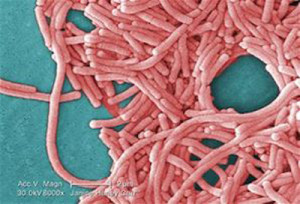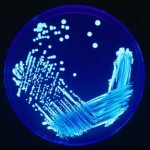Legionnaires’ Disease (LD), also called legionellosis, causes a severe type of pneumonia (lung infection) that often involves other organs, including the brain and heart. People contract LD by breathing in water mist containing Legionella bacteria.
What is Legionella?

Legionella is the single genus of the family of bacteria known as Legionellaceae. Almost all cases of human illness (70-90%) are caused by one species, Legionella pneumophila, and one serotype of that species, serogroup 1. This means that 30-10% of cases are caused by other serogroups of L. pneumophila (there are 15 of them) and other species of Legionella.
Diagnosing Legionnaires’ Disease
CDC Guidelines for Who to Test
The CDC guidelines do not recommend LD testing for every patient with pneumonia, although that would catch more cases. It does recommend testing for the following:
- Patients who have failed outpatient antibiotic therapy;
- Patients with severe pneumonia, in particular those requiring intensive care;
- Patients who have compromised immune systems (cancer, HIV, diabetes) and have pneumonia;
- Patients who are diagnosed with pneumonia during a Legionnaires’ Disease outbreak;
- Patients who traveled within the 2 week incubation period; and
- Patients suspected of healthcare-associated pneumonia (hospital, nursing home, rehabilitation center).
Some cases of LD go undiagnosed because every case of severe pneumonia is not tested. We would like to see a stronger recommendation from the CDC that all cases of pneumonia from an unknown source be tested for detection of LD (legionellosis). We would also like to see an effort made to educate healthcare professionals regarding this.
Urinary Antigen Test Should Only be a First Step

- The urinary antigen test only reliably detects L. pneumophila serogroup 1, leaving 10-30% of cases undetected1; and
- Results of a test on a culture of a Legionella isolate from a patient (clinical isolate) can prove the patient is part of a Legionnaires’ Disease outbreak and can be compared to environmental isolates (samples of water from cooling towers, etc.) to find the source of the Legionella.
In other words, sending cultures in for testing results in more accurate diagnosis for treatment purposes and provides information that can be used to find the source of an outbreak, both laudable public safety goals.
For LD patients, it means they they have a better chance of getting the treatment they need and that they will have the evidence needed to file a lawsuit for compensation against the building owner responsible for their illness. These are personal injury cases. If the patient tragically dies, the family has a wrongful death claim.
We urge the CDC to take measures to ensure that a urinary antigen test AND a culture of respiratory secretions is done on all patients with severe pneumonia in the United States when there is any suspicion of LD.
1. Thomas, Stephanie, et al. “Two cases of community acquired Legionella pneumophila non‐serogroup 1 in patients undergoing extra corporeal membrane oxygenation for severe respiratory failure.” JMM Case Reports 2.1 (2015): e000002.